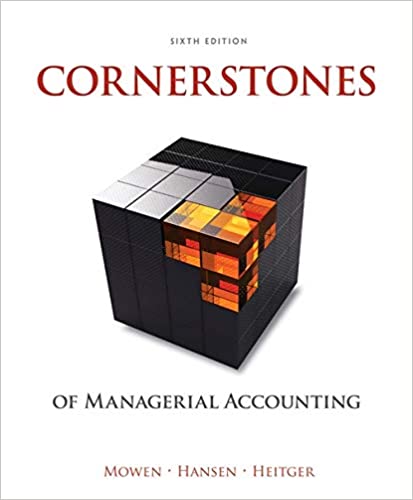
Cornerstones of Managerial Accounting 6th Edition by Maryanne Mowen,Don Hansen ,Dan Heitger
Edition 6ISBN: 978-1305103962
Cornerstones of Managerial Accounting 6th Edition by Maryanne Mowen,Don Hansen ,Dan Heitger
Edition 6ISBN: 978-1305103962 Exercise 9
Variable Costing, Absorption Costing, Segmented Income Statements, Inventory Valuation
During its first year of operations, Sugarsmooth Inc. produced 55,000 jars of hand cream based on a formula containing 10% glycolic acid. Unit sales were 52,300 jars. Fixed overhead totaled $27,500 and was applied at the rate of $0.50 per unit produced. The results of the year's operations are as follows (on an absorption-costing basis):

At the end of the first year of operations, Sugarsmooth is considering expanding its customer base. In its first year, it sold to small drugstores and supermarkets. Now, Sugarsmooth wants to add large discount stores and small beauty shops. Working together, the company controller and marketing manager have accumulated the following information:
a. Anticipated sales to discount stores would be 20,000 units at a discounted price of $5.80. Higher costs of shipping and return penalties would be incurred. Shipping would amount to $8,500 per year, and return penalties would average 4% of sales. In addition, a clerk would need to be hired solely to handle the discount stores' accounts. The clerk's salary and benefits would be $28,000 per year.
b. Anticipated sales to beauty shops would be 10,000 units at a price of $9. A commission of 10% of sales would be paid to independent jobbers who sell to the shops. In addition, an extra packing expense of $0.50 per unit would be incurred because the shops require fewer bottles per carton.
c. The sales to small drugstores and supermarkets will remain the same.
d. The fixed overhead and selling and administrative expenses would remain unchanged and are treated as common costs.
Required:
1. Calculate the cost of Sugarsmooth's ending inventory at the end of the first year under absorption costing.
2. Calculate the cost of Sugarsmooth's ending inventory at the end of the first year under variable costing. What is operating income for the first year using variable costing?
3. Prepare a segmented variable-costing income statement for next year. The segments correspond to customer groups: drugstores and supermarkets, discount stores, and beauty shops.
4. CONCEPTUAL CONNECTION Are all three customer groups profitable? Should Sugarsmooth expand its marketing base?
During its first year of operations, Sugarsmooth Inc. produced 55,000 jars of hand cream based on a formula containing 10% glycolic acid. Unit sales were 52,300 jars. Fixed overhead totaled $27,500 and was applied at the rate of $0.50 per unit produced. The results of the year's operations are as follows (on an absorption-costing basis):

At the end of the first year of operations, Sugarsmooth is considering expanding its customer base. In its first year, it sold to small drugstores and supermarkets. Now, Sugarsmooth wants to add large discount stores and small beauty shops. Working together, the company controller and marketing manager have accumulated the following information:
a. Anticipated sales to discount stores would be 20,000 units at a discounted price of $5.80. Higher costs of shipping and return penalties would be incurred. Shipping would amount to $8,500 per year, and return penalties would average 4% of sales. In addition, a clerk would need to be hired solely to handle the discount stores' accounts. The clerk's salary and benefits would be $28,000 per year.
b. Anticipated sales to beauty shops would be 10,000 units at a price of $9. A commission of 10% of sales would be paid to independent jobbers who sell to the shops. In addition, an extra packing expense of $0.50 per unit would be incurred because the shops require fewer bottles per carton.
c. The sales to small drugstores and supermarkets will remain the same.
d. The fixed overhead and selling and administrative expenses would remain unchanged and are treated as common costs.
Required:
1. Calculate the cost of Sugarsmooth's ending inventory at the end of the first year under absorption costing.
2. Calculate the cost of Sugarsmooth's ending inventory at the end of the first year under variable costing. What is operating income for the first year using variable costing?
3. Prepare a segmented variable-costing income statement for next year. The segments correspond to customer groups: drugstores and supermarkets, discount stores, and beauty shops.
4. CONCEPTUAL CONNECTION Are all three customer groups profitable? Should Sugarsmooth expand its marketing base?
Explanation
Activity based costing:
• Activity base...
Cornerstones of Managerial Accounting 6th Edition by Maryanne Mowen,Don Hansen ,Dan Heitger
Why don’t you like this exercise?
Other Minimum 8 character and maximum 255 character
Character 255


